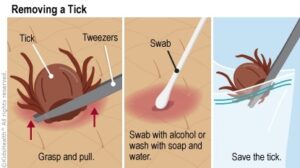A Note from Nurse Pam
Ticks are out in full force. Most tick bites are harmless and don’t need medical treatment. Deer ticks are tiny, no larger than a pencil point. Other ticks are larger and easier to find on the skin. Some ticks, especially deer ticks can cause tick-borne illnesses so it is important to do frequent tick checks.
Removing tick
- Use tweezers to grasp the tick firmly at its head or mouth, next to the skin. Use a magnifying glass, if you have one, to see the tick clearly.
- Pull firmly and steadily until the tick lets go of the skin. Do not twist the tick or rock it from side to side. Parts of the tick might stay in the skin, but eventually will come out on their own.
- Wash your hands and the site of the bite with soap and water.
- Swab the bite site with alcohol to disinfect the skin.

Watch out for:
- A red bump ringed by an expanding red rash, which looks like a bull’s-eye (Lyme disease)
- Red dots on the ankles and wrists (Rocky Mountain spotted fever)
- Flu-like symptoms such as fever, headache, tiredness, vomiting, and muscle and joint aches
Call your doctor if:
- Your child has had a tick bite, especially if the tick might have been on the skin for more than 24 hours. Sometimes, doctors prescribe a preventive dose of antibiotics for kids at high risk for Lyme disease.
- Part of the tick remains in the skin.
- A rash of any kind develops (especially a red-ringed bull’s-eye rash or red dots on wrists and ankles).
- The bite area looks infected (increasing warmth, swelling, pain, or oozing pus).
- Your child gets symptoms like a fever, headache, tiredness, stiff neck or back, joint swelling, or muscle or joint aches.
- Your child has facial paralysis (can’t move areas of the face).
How Can I Protect My Kids From Ticks?
To help prevent tick bites:
- After kids play outside, check their skin and hair — especially the scalp, behind the ears, around the neck, in the eyebrows and eyelashes, and under the arms. They should wear long sleeves and pants with legs tucked into their socks.
- Use an insect repellent with at least 10% to 30% DEET for protection against bites and stings in kids older than 2 years. Always carefully follow the label directions for applying.
- Clothes also can be treated with a specific insecticide (like permethrin) to help prevent bites.
- Wash kids’ skin with soap and water when they come back inside. If you’ve been in an area with ticks, wash all clothes in hot water and tumble dry on high heat before they’re worn again.




